Contributory members are able to log private notes and comments about each site
Sites Anne T has logged. View this log as a table or view the most recent logs from everyone
Rockcliffe (Cumbria)
Trip No.38 Entry No.3 Date Added: 18th Aug 2017
Site Type: Ancient Cross
Country: England (Cumbria)
Visited: Yes on 17th Aug 2017. My rating: Condition 3 Ambience 4 Access 5

Rockcliffe (Cumbria) submitted by Anne T on 18th Aug 2017. First view of the Rockcliffe Cross from the iron gates by the mounting block. It sits to the right of the path leading to the south porch.
(View photo, vote or add a comment)
Log Text: The Rockcliffe Wheel-headed Cross, Cumbria: From the centre of Carlisle, we followed the signs heading north on the A7, out to the large Asda by the M6. Just before junction 44, a road north west into the industrial estate, clearly signposted to Rockcliffe.
This road leads straight into the village, with the church being on the south western corner of the village where the minor road turns right. There is room to park by the main iron gates to the church, next to the mounting block, in a small triangular piece of road.
Immediately inside the gates, the cross is straight in front of you, just to the right of the path leading to the south porch. Nearby is a modern grave marker in a smaller, but similar shape.
The church sits on a promontory, and as you walk down to the south porch a bend of the River Eden comes into view. On the north side of the church the land drops sharply down to Rockcliffe Beck with some graves on the terrace below. Even I was intrigued enough to walk the narrow path along the northern side of the church because I wanted to see the layout of the churchyard.
Sadly the church was locked, as I’d loved to have seen inside.
St Ninian's Well (Brisco)
Trip No.39 Entry No.2 Date Added: 31st Jul 2019
Site Type: Holy Well or Sacred Spring
Country: England (Cumbria)
Visited: Yes on 17th Aug 2017. My rating: Condition 3 Ambience 3 Access 4
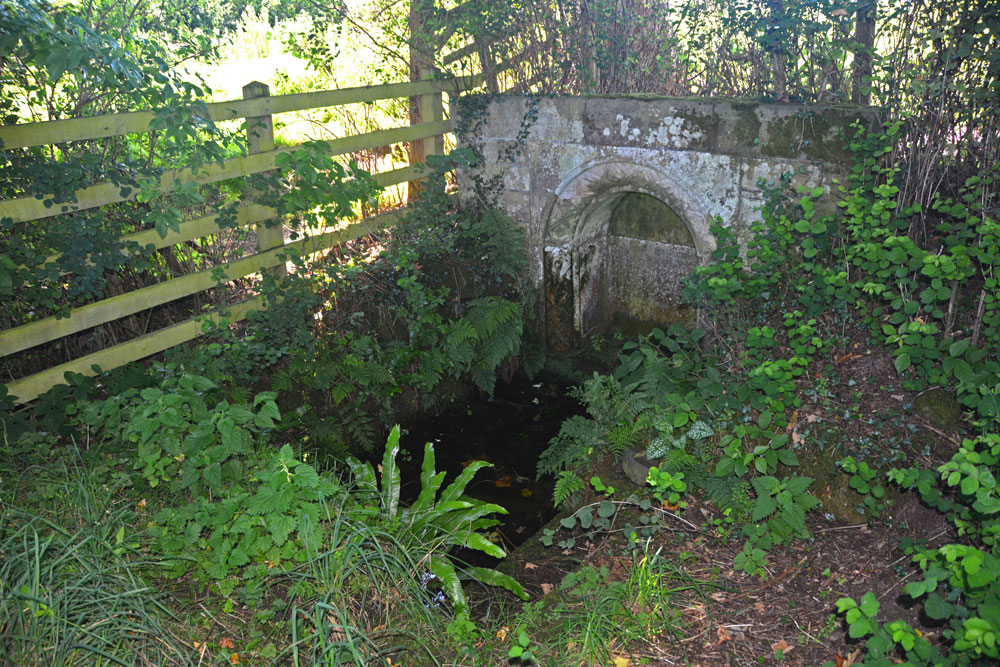
St Ninian's Well (Brisco) submitted by Anne T on 18th Aug 2017. First view of St Ninian's Well as we turned the corner of the dog-leg in the footpath.
(View photo, vote or add a comment)
Log Text: St Ninian's Well, Brisco, Cumbria: From Carlatton Demesne Standing Stone, heading back onto the A69, we took the M6 to junction 42, then the third exit towards Durdar. Brisco (Briscoe according to Pastscape) is the first turn to the right. The village is a line of houses on both sides of the road. We parked where the road widened slightly at Brisco Hall farm and walked back southwards to the footpath, which runs to the north of Well View cottage (they have a sign on the side of the house saying their drive is Elvis Presley Boulevard!), and followed the grassy lane down towards the railway line. Where the path does a right hand turn, there is a small set of stone steps. The footpath then turns north east towards the railway line, going through a gate into a field. The well is in this small enclosed area, tucked away at its south eastern end, mostly hidden by shrubs and brambles.
There is an arched well head that looks Victorian, and Pastscape and Historic England says was erected in the 1830s to 1840s. A step goes down to the well basin, in which, under the water, is a circular structure with a circular hole in its middle. In the corner of the fence facing the well is a small wooden bench, covered by brambles when we visited, but we used sticks to move these away and sit and admire this spot.
From the well, a gate leads through a fence-line down into a field of pasture below (the ground drops by 3-4 feet and there are steps down to the new ground level). This ground is wet and boggy and in line with the well head and pool is a cattle truck. A steady trickle of water comes through the bottom of the trough into a pool which has large boulders pushed around it in a partial circle, now partly destroyed. It looks like this might have been the original well pool. At the bottom of the field, the main west coast railway line runs and we watched several intercity trains and a steam train go by before returning to go into Carlisle for a late lunch then onto our next stop – a wheel-headed cross north west of Carlisle in Rockcliffe.
Carlatton Demesne
Trip No.39 Entry No.1 Date Added: 18th Aug 2017
Site Type: Standing Stone (Menhir)
Country: England (Cumbria)
Visited: Yes on 17th Aug 2017. My rating: Condition 3 Ambience 4 Access 4
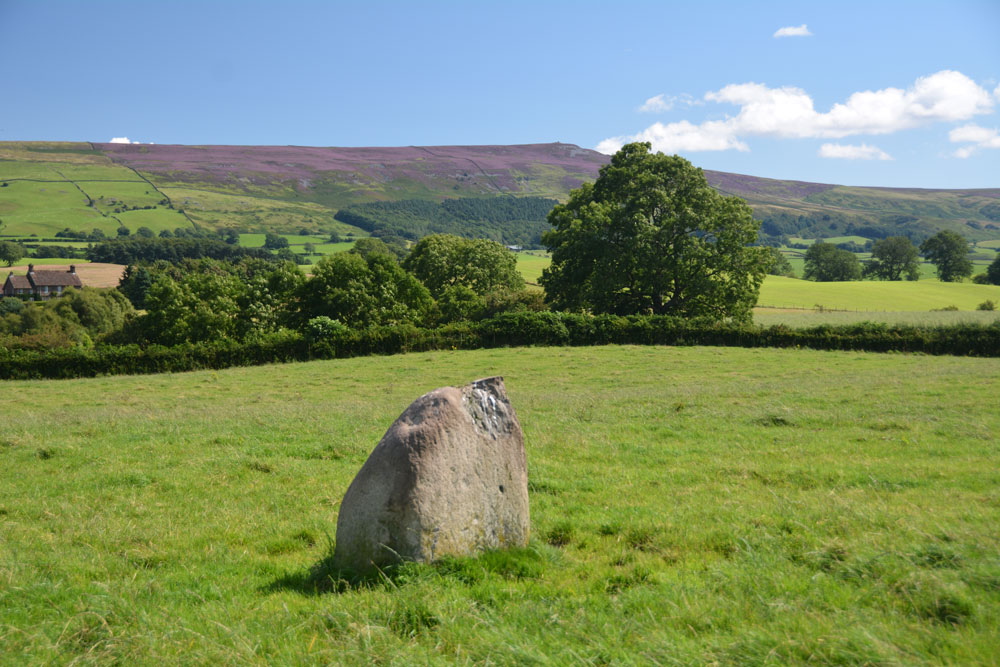
Carlatton Demesne submitted by Anne T on 18th Aug 2017. Standing on the edge of the slight mound on which the stone sits, looking south east towards Castle Carrock Fell.
(View photo, vote or add a comment)
Log Text: Carlatton Demesne Standing Stone: Following the A69 to Carlisle, the only way we could turn left off the A69 to get to Carlatton was to drive north into Brampton and back out again, under the A69. We then followed the B6413 through Castle Carrock, turning off westwards along the minor road past Moor House and Black Dub. The entrance to Carlatton Demesne Farm is around 650 metres further south of the track to Black Dub farm and there is a small hard-cored area just to the south of Carlatton Demesne Farm track, alongside the road.
At first, we walked back towards the small wood to the north-north-east to where we’d seen a gate. The gate was only held up by four pieces of wire and was very rickety, so we abandoned attempts to climb over and walked back up the farm track to where the footpath ran. I heard the farmer start his machinery up in the yard so walked along to have a word with him. It was actually a young farm worker who told me it was OK to walk through the field to look at the standing stone. He told me if we carried along the road towards Penrith, we’d get some pretty spectacular views. In the end, we retraced our steps and didn’t go down that way, but will bear that in mind for future visits.
The countryside is very pretty here, although gaining entry into the field was fun with its very muddy patch by the gate, and having stepped into the pasture, there were hidden, still soft cow pats hidden under the calf length grass. Our stone is number 4 in the list below. It appeared to be sited on top of a small, but pronounced mound with superb views around 360 degrees, with Carrock Fell to the east. It would have been a splendid setting for a stone circle.
Plotting out the points on UK Grid Reference Finder, the NGRs mentioned below form a loose alignment rather than a circle.
St Mary's Motte (Beaumont)
Trip No.40 Entry No.8 Date Added: 25th Aug 2017
Site Type: Misc. Earthwork
Country: England (Cumbria)
Visited: Yes on 20th Aug 2017. My rating: Condition 3 Ambience 4 Access 5
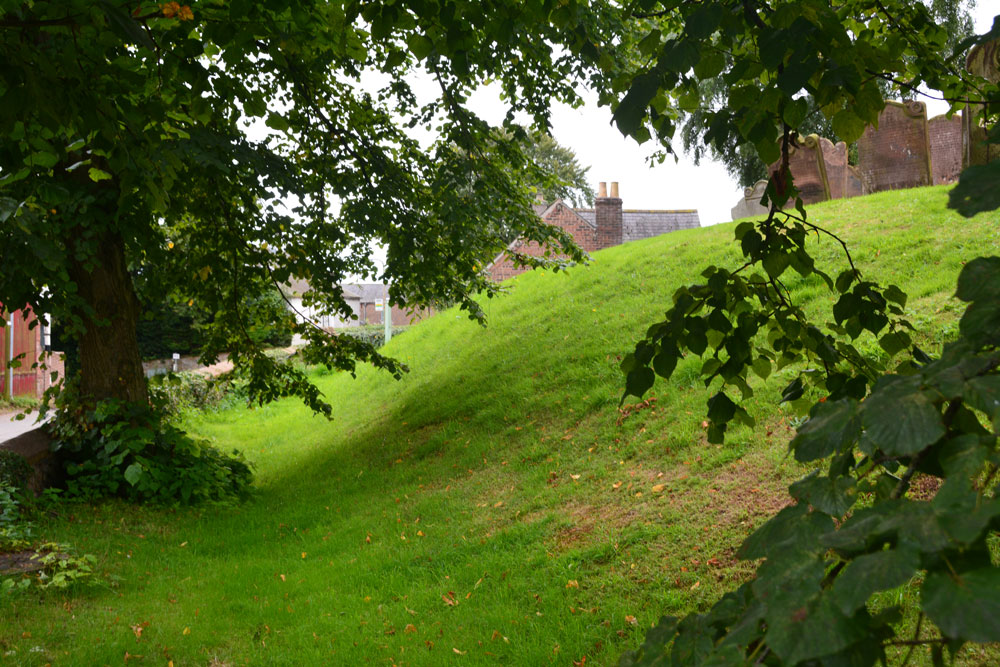
St Mary's Motte (Beaumont) submitted by Anne T on 22nd Aug 2017. Looking at the southern section of the motte, which has been partly cut by the modern road through the village. Pastscape says that the site may originally have been a Saxon or Danish settlement, then the site of turret 70a on Hadrian's Wall, then a Norman motte, finally being replaced by the church in the 12th century.
(View photo, vote or add a comment)
Log Text: St. Mary's Beaumont: Church built on a motte, on a milecastle on a possible Saxon camp: We came to try to see St. Ann’s Well, marked on the OS map as being just off the small triangular village green, but found it was in a private garden surrounded by either a tall hedge or other buildings, so there was no access and no-one around to ask. According to the Old Cumbria Gazetteer, the well is at NY35055942, which is nearer the River Eden, says the well is at NY35055942 (which is different to the OS map) and: “This provided very cold water, useful for helping set the butter. By the time you’d got back up the bank your bucket was only half full.” Dated to 1867 to 1868.
There were lots of walkers trundling along Hadrian’s Wall Path at this point, with a large notice by the interpretation board saying there was a detour due to a large landslip. By this time, my attention had been grabbed by the interpretation board saying this church was built on the line of Hadrian’s Wall and that at one point, a turret (70A) would have stood on the site of the church. The church guide continues: “When the Normans arrived they constructed a motte and baillie as a vantage point to repel invasion from the Scots …. Stones from the wall provided ready building material.”
This is a very pleasant spot. There were so many tractors driving around at this time of the evening we felt out of place! There are farms all along the road through the village. I’d have liked to have seen across to the River Eden, but the farm buildings and houses along its western bank obscured the view. We decided on one final visit, to try and see St. Edward’s Monument (so wet we couldn’t get near last time).
St Andrew's Well (Kirkandrews-on-Eden)
Trip No.40 Entry No.6 Date Added: 22nd Aug 2017
Site Type: Holy Well or Sacred Spring
Country: England (Cumbria)
Visited: Yes on 20th Aug 2017. My rating: Condition 3 Ambience 4 Access 4
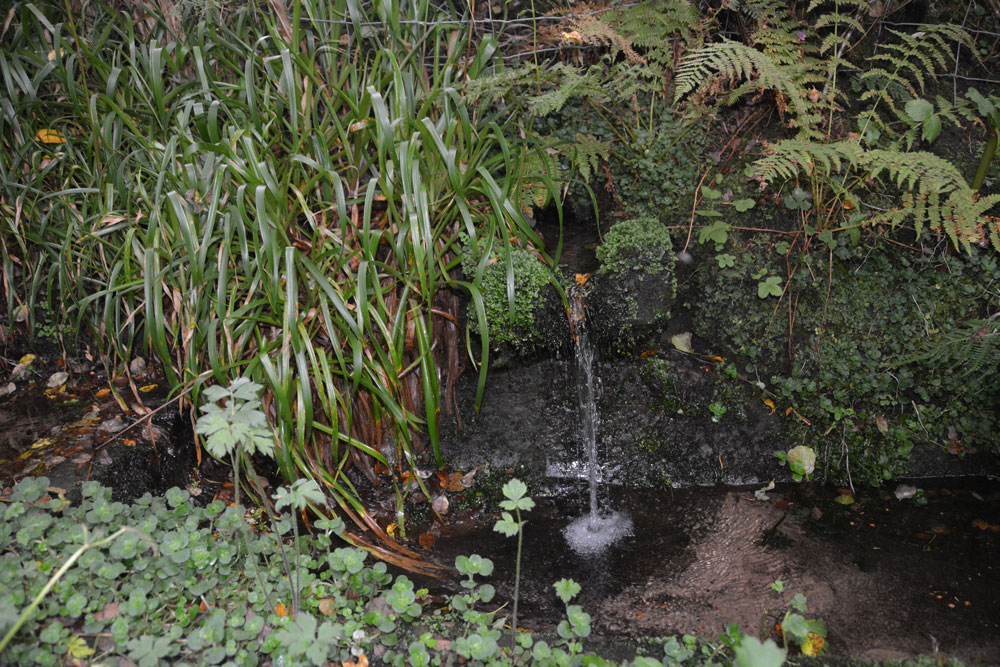
St Andrew's Well (Kirkandrews-on-Eden) submitted by Anne T on 22nd Aug 2017. Standing looking at the bank where the spring emerged, with the well pool - a rectangular stone (or brick?) basin - below. There was a steady flow of water, which could be heard from quite a way away.
(View photo, vote or add a comment)
Log Text: St Andrew's Well, Kirkandrews-on-Eden: From Stapleton, we headed to junction 44 of the M6 and stopped for refreshments at Houghton Park Garden Centre, then set off via the A689 (western part of the bypass round Carlisle, turning right at the roundabout where the A689 joins Burgh Road. Kirkandrews is almost 2.5 km to the north west of this point.
In the middle of Kirkandrews-on-Eden the road splits. The left hand fork goes directly to Monkhill, the right hand fork to Beaumont. The old churchyard is somewhat hidden behind bushes, but is approx. 120 metres from the fork in the road. We parked at the wide farm entrance a little further up the road and walked back to the footpath sign.
We followed the footpath for about 50 metres (the old grave stones peer out of the very high grass to your right hand side. As the path starts to descend, we could hear a steady trickle of water and found the well hidden behind weeds that were as tall as I was. Gently moving these aside, so we have a clear view (we thought the weeds might be poisonous) I took photographs. My husband announced this was a very spooky spot (overgrown trees next to a decidedly no longer used grave yard) although I found it strangely tranquil.
There was a channel running down the hillside taking rainwater down to the well pool. The main water came out of the bank to the side at a 90 degree angle to the sandstone basin, then trickled down into a second channel running down the hill.
The basin was much silted up with sandy soil but the flow was strong and clear. Although Pastscape says the well pool is 1.0 metre square, I thought it was rectangular, measuring 1.5 m long b about 80cm wide.
Don’t know what happened to the church, but then just discovered the small mention below – closed in the 1750s with no visible evidence remaining.
St Mary's Church (Walton)
Trip No.40 Entry No.1 Date Added: 22nd Aug 2017
Site Type: Ancient Cross
Country: England (Cumbria)
Visited: Yes on 20th Aug 2017. My rating: Condition 3 Ambience 3 Access 5

St Mary's Church (Walton) submitted by Anne T on 22nd Aug 2017. Standing nearer to the south western corner of the church looking back at the cross shaft. The stone is badly shattered and spalled off on this side.
(View photo, vote or add a comment)
Log Text: St. Mary's, Walton: Went to see a cross head, but found an 11th century market cross instead! This is a very pretty little village, and was on our way back to Stapleton to try to find the Bride’s Well (ran out of time last Thursday). We parked opposite the church on the side of the village green and walked across to the church, letting ourselves in through the rather rusty gate (it took us ages to work out how to open it). I excitedly followed my husband into the church but stopped dead as there was no sign of the cross head at all.
We hunted under pews, up and down the aisles, on window ledges, around the font, inside a chest, and all the places we could think of. The only sign of the cross was a photograph and a brief description on the display boards against the north western wall of the nave, which showed it displayed on top of the font cover. (I’ve since sent an email to the vicar to enquire where it might be located or moved to, but not had a reply yet).
We did however, see a paragraph on the display boards headed AD850 to 1066: “During the latter part of the 9th century to the middle of the 11th century, Walton, as a community, developed. The evidence for this is shown by the relics found in or around the present church. Between the years of 850 to 950, a preaching cross was erected and similarly between 1000 and 1050, a market cross was probably erected.” There is an image of the remains of the market cross in the churchyard. We then went to find this, disappointed not to have found the cross head, but pleased there was something of antiquity to have made this detour worthwhile.
King Edward's Monument
Trip No.40 Entry No.7 Date Added: 22nd Aug 2017
Site Type: Cairn
Country: England (Cumbria)
Visited: Yes on 20th Aug 2017. My rating: Condition 3 Ambience 4 Access 4

King Edward's Monument submitted by Anne T on 22nd Aug 2017. First view of the monument from the parking area at NY 32876 60329
(View photo, vote or add a comment)
Log Text: King Edward's Monument, Burgh-by-Sands: After having visited Beaumont, I was reluctant to go home without seeing something of the Solway, and looking across to Dumfries & Galloway, where we spent 12 years. When we last visited in February 2014 we were unable to get down the lane because it was so waterlogged (we got about one third of the way down and had to abandon the visit, having seen the monument only from afar). This time, the lane looked dry, so we parked by the little triangle of grass and could see the monument on the marshland below.
Appearances were certainly deceptive – parts of the lane were ankle deep in mud, and we picked our way from the track to the marshy grass land next to it, to dry stones and boulders where we could. Eventually we came to the stile over a small stream at NY 32773 60897, which led immediately down to a small wooden bridge and onto another stile. The other side of this stile was deep in water, but thankfully previous walkers had moved ‘stepping stones’ into the water. Once onto Burgh Marshes, the mounds left by ridge and furrow ploughing kept our feet dry until we got to the monument. Parts by the brick wall/metal railings surrounding the monument looked as if it was surrounded by a small moat!
What a place to have waited to cross the Solway. I think I would have preferred to have seen the original cairn rather than this Victorian monstrosity. The chimneys of Chapelcross, the decommissioned nuclear power plant, could be seen across the estuary, together with the flattened hilltop of Burnwark hillfort.
At the time of our visit, the tide was out, but I could imagine the shimmering water of the Solway to the west. A fitting end to a nice afternoon out.
Hall Well (Irthington)
Trip No.40 Entry No.2 Date Added: 24th Aug 2017
Site Type: Holy Well or Sacred Spring
Country: England (Cumbria)
Visited: Yes on 20th Aug 2017. My rating: Condition 2 Ambience 3 Access 5
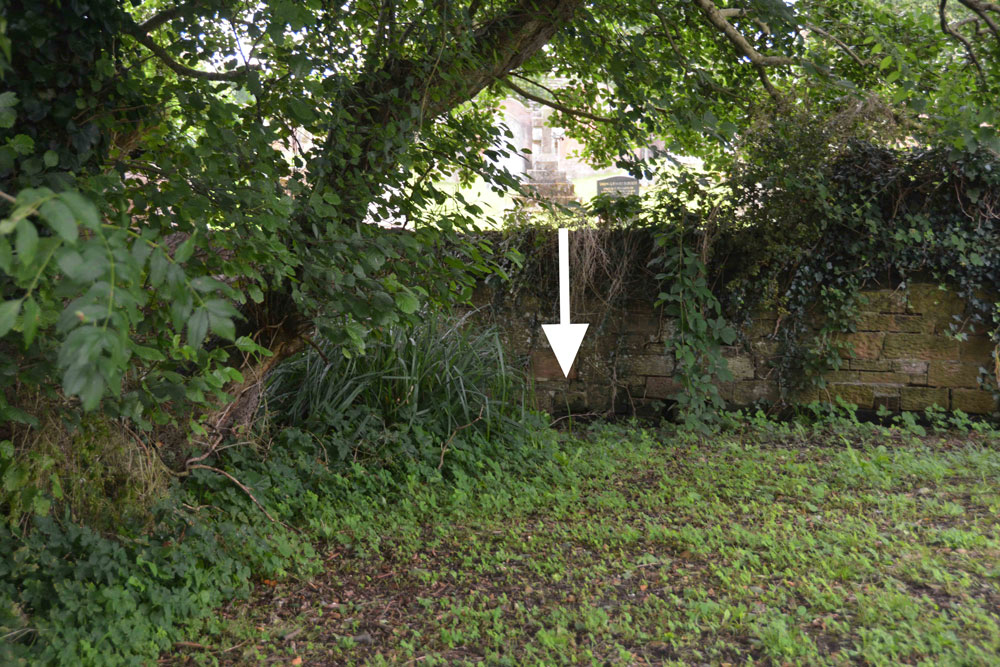
Hall Well (Irthington) submitted by Anne T on 24th Aug 2017. At the southern end of this small grassy area is a boggy area. Just underneath the wooden fence into the neighbouring garden a stream appears from under the bank. This stream has a good flow of water.
(View photo, vote or add a comment)
Log Text: Hall Well, Irthington: From Walton we made our way over to Irthington – not a planned visit, but because I saw the holy well and 2 mottes in close proximity in this village.
This small village (too large to be called a hamlet, but too small to be a good sized village) is obviously old. It’s not that far from Carlisle Airport and stands on the line of Stanegate and is also close to the line of Hadrian’s Wall.
Being armed with the OS map and a GPS, we went in search of the holy well first (passing by the first motte as we’d look for somewhere to park on the way back). According to the OS map the well lies not far outside the south-eastern wall of the church yard. Walking through the churchyard, this area is covered in brambles, nettles and shrubs, but we found some steps leading through the wall and onto the grassy area beyond. At the grid reference above there are some reeds and shrubs sitting in a boggy area. Peering over the fence into the garden of the house sitting immediately to the south, a stream suddenly appears out of the ground and rushes through the garden and is piped under the road, presumably to the modern water pumping station opposite. Nothing exists of any well housing (that we could see) and I’ve emailed the vicar through the ‘A Church Near You’ website.
Just down the road is one of the mottes. Note: the grid reference given by Pastscape indicates the site of the well is around the steps from the churchyard.
Irthington Mill
Trip No.40 Entry No.4 Date Added: 25th Aug 2017
Site Type: Misc. Earthwork
Country: England (Cumbria)
Visited: Yes on 20th Aug 2017. My rating: Condition 2 Ambience 3 Access 5
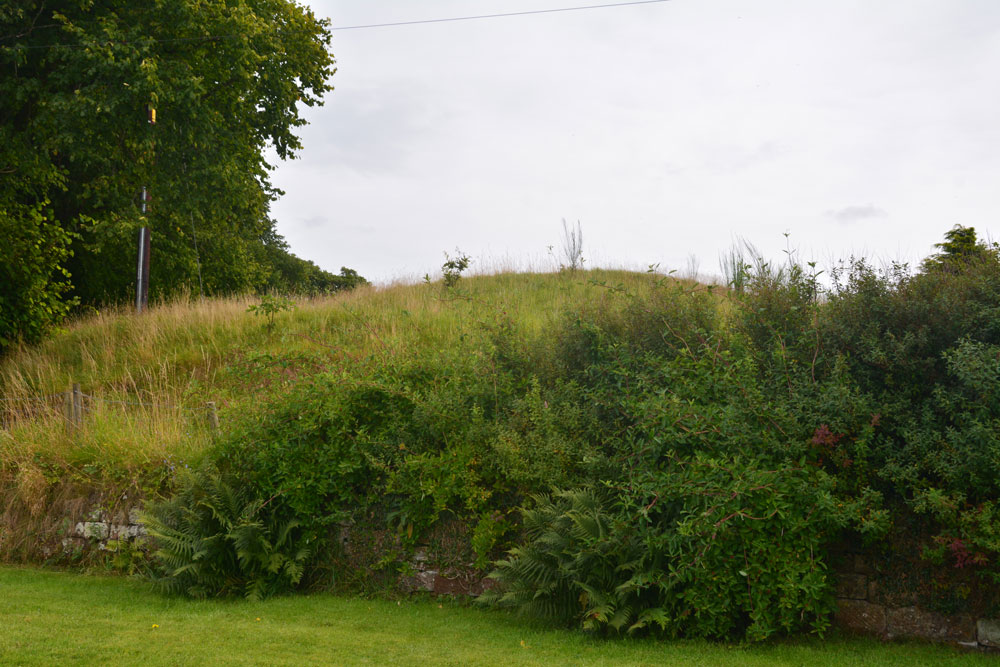
Irthington Mill submitted by Anne T on 25th Aug 2017. The 'motte' from near the driveway to Irthington Mill house. Fancy having part of your garden growing on such an old feature, especially if it is a motte!
(View photo, vote or add a comment)
Log Text: Irthington Mill 'motte or not?': Having spotted two mottes and a holy well just off the road we were travelling on to Carlisle, I asked to take a detour to find these. Whilst this is marked as a motte on the OS map, and certainly looked like one, I got home to find there is some debate about whether this is a motte or a natural feature (it is not recorded on Historic England’s listings).
Situated between a farm with some very old buildings and Irthington Mill house, with part of the Mill’s garden growing up its western slope, and not far from Irthington Bridge, it seemed to me that this motte was in a much more strategic defensible position near the modern day river crossing. Perhaps the course of the river moved over the years and the site of the motte was changed? This is me not wanting to belive its just a natural feature!
Bride's Well (Stapleton)
Trip No.40 Entry No.5 Date Added: 25th Aug 2017
Site Type: Holy Well or Sacred Spring
Country: England (Cumbria)
Visited: Yes on 20th Aug 2017. My rating: Condition -1 Access 4
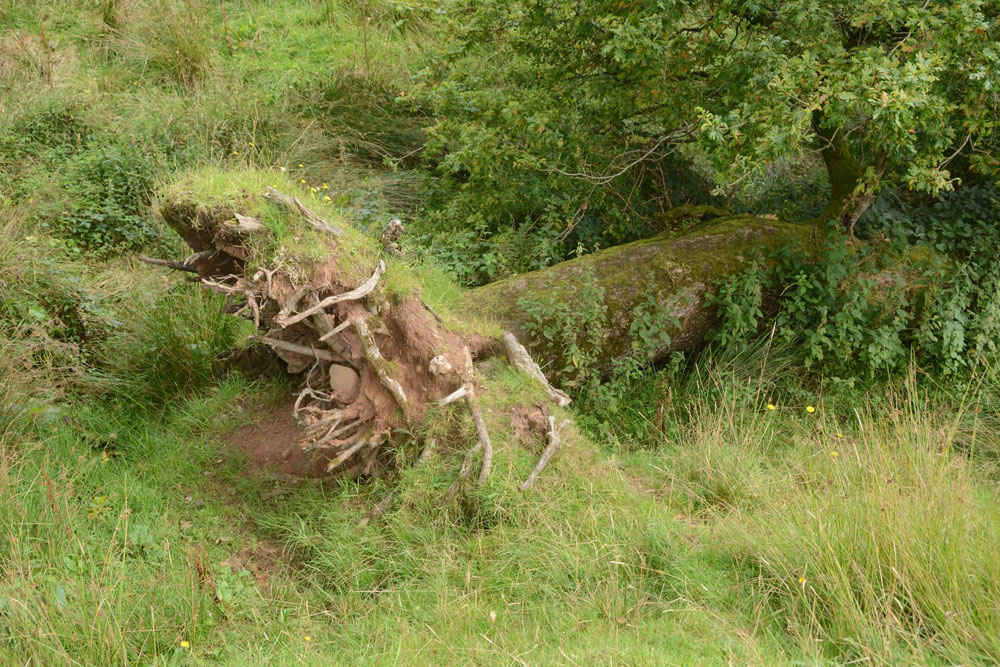
Bride's Well (Stapleton) submitted by Anne T on 25th Aug 2017. This was the fallen tree which lies over the position given for Bride's Well at St Mary's Church in Stapleton, so it may possibly be destroyed. The church warden I contacted thinks the well is in a field behind the vicarage and is going to check and get back to me.
(View photo, vote or add a comment)
Log Text: Bride's Well, Stapleton: Now underneath a fallen tree? Having had to run away from this site to collect our cats from the vets after a very brief search for the well last Thursday, we went back armed with the GPS and OS map and found we’d been looking in the wrong direction.
I’d seen a set of stile leading down to the meadow from the eastern side of the church yard so we found these. They led down to the meadow and the burn running north-south through the field, although they were completely overgrown by nettles. Whilst there were only two small steps on the church yard side, there were around 8 going down into the field below.
We walked round and round and the only feature we could see at the exact grid reference given by Pastscape was this fallen tree. Has the well been destroyed? We had a good look round all along the stream in this field.
I sent an email to the Rector when I got home, and received the reply below. She thinks the well might be in the field behind the rectory, which is above the church, and will check and send an update.
Dacre Church
Date Added: 6th Nov 2017
Site Type: Ancient Cross
Country: England (Cumbria)
Visited: Yes on 5th Nov 2017. My rating: Condition 3 Ambience 4 Access 5
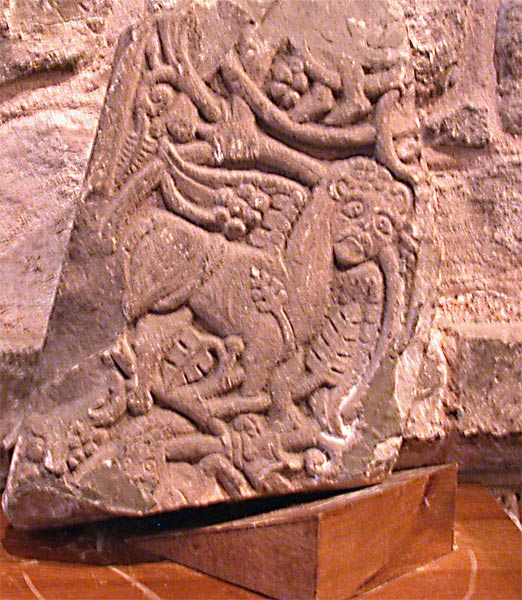
Dacre Church submitted by nicoladidsbury on 22nd May 2005. St Andrew's Church - 9th Century Cross Fragment.
This is the smaller fragment, which is believed to date from the 9th century, was found in 1900 close to the Church and deep in clay. It is considerably damaged but some detail of the carving is still quite sharp. The least damaged face of the shaft, where the top has been broken off, shows two pairs of human feet. Beneath is a lion-like winged creature, with a large face and sorrowful eyes, with the head and part of the body of a serpent.
(View photo, vote or add a comment)
Log Text: St Andrew's Church, Dacre: Anglo Saxon Cross Fragments: We'd visited this church back in early 2014, before I joined the Portal, to photograph the bears; the church was firmly locked on the day of our visit. This time, the door was open, and we walked into this lovely church, parts of which are extremely old. The smell of the nave was reminiscent of the church where I used to sing in the choir when I was 10/11 years old - it's been a long time since I was reminded of those ancient days!
I'd called up the Corpus of Anglo Saxon Stone Sculpture website, which showed four recorded stones for Dacre. We could only find 3 (2 of them combined in the Dacre entry), Dacre 3 having been removed to Lancaster University. Despite an intensive hunt, Dacre 1 was also not to be found.
Dacre 4, in the exterior south wall of the chancel took some finding; to my very untrained eye, the motif could have been weathering. Glad I have the Corpus image to refer to, and then it took two of us well over five minutes to find it!
Mossthorn Long Cairn 1
Trip No.60 Entry No.3 Date Added: 24th Nov 2017
Site Type: Cairn
Country: England (Cumbria)
Visited: Yes on 20th Nov 2017. My rating: Condition 2 Ambience 4 Access 3

Mossthorn Long Cairn 1 submitted by Anne T on 24th Nov 2017. Approaching the northern end of the this long, rectangular cairn, which was made up of small to medium sized stones and earth.
(View photo, vote or add a comment)
Log Text: Mossthorn Long Cairn, Copt Howe, Newton Reigny: We wrote to Mossthorn Farm immediately after our last visit here in February 2017, but our letter was ignored and we didn’t get a reply. A local historian, who we’d made contact with to find out more about the standing stones / stone row said he had contacts who would give permission for us to visit, but nothing.
In our latest visit to Newbeggin, we went armed with wellington boots and socks and trudged down the lanes from the southern side of Newton Reigny. Whilst the lane is gated, it looks to be frequently used by walkers, so we followed the footpath to Copt Howe at NY 48258 30770. The gate into the field was wide open and a large dung heap had been placed near the field gate. As the rest of the field was pasture, we decided to walk quickly over to the long cairn and take a closer look. The field was very boggy and I was glad of my wellies.
Strangely, I noticed lots of quartz stones scattered around the perimeter of the cairn, shining white in the drizzle amongst the brown-red earth. This cairn had plenty of stones down its length.
We saw the side of Mossthorn Long Cairn 2 that we hadn’t seen before from the eastern hedge line of the field but didn’t want to incur the wrath of the farmer, who was working on his tractor in the field nearby.
Newton Reigny Enclosure
Trip No.60 Entry No.2 Date Added: 26th Nov 2017
Site Type: Misc. Earthwork
Country: England (Cumbria)
Visited: Yes on 20th Nov 2017. My rating: Condition 2 Ambience 3 Access 5
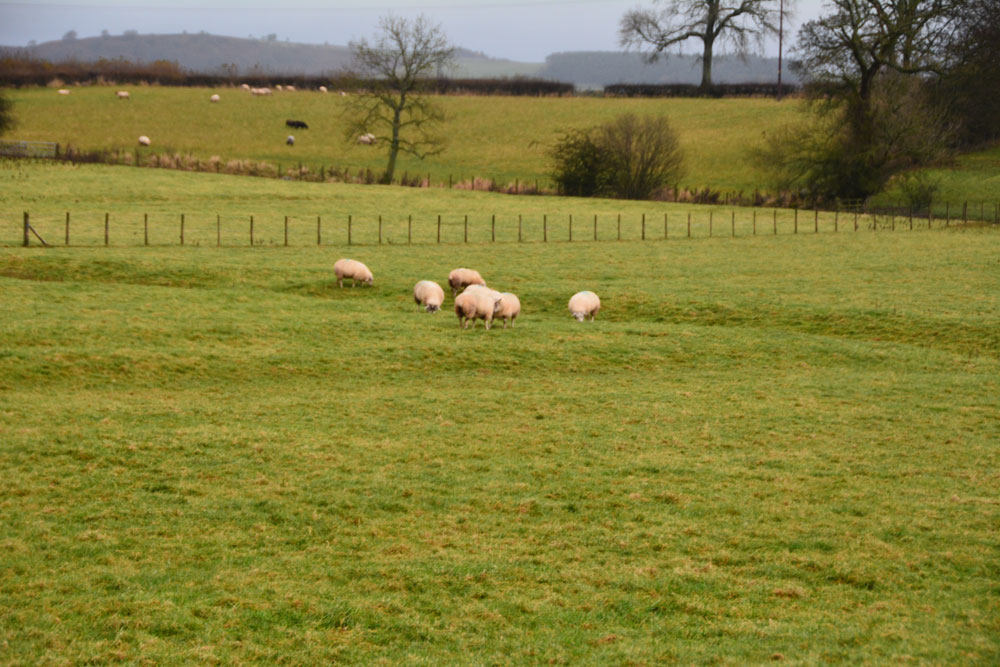
Newton Reigny Enclosure submitted by Anne T on 26th Nov 2017. Standing at the gate to the field containing part of this enclosure, looking north. A series of low banks and ditches can be seen, largely to the left hand side of the small cluster of sheep. Not a huge amount to be seen, but this site is believed to be of Dark Ages origin, according to the Curator of Carlisle Museum.
(View photo, vote or add a comment)
Log Text: Newton Reigny Enclosure: Having put the wellies in the back of the car, we decided to try and walk along the lanes from the south of Newton Reigny, where traditionally one of the stone rows ran towards Newbeggin. On our last visit, back in February 2017, the lane was ankle deep in water and mud.
I spotted this enclosure on the map, and keen to see something other than possible (non-existent) standing stones, was keen to see something of historic value. There were road works immediately opposite the field this enclosure was in, and the workmen, who were partly blocking the road waved us through. We, however, didn't want to be waved on, so my husband drove just past where they were working and I hopped out with the camera, much to the amusement of the workmen who must have wondered what we were looking at.
There were the outlines of low banks and a deeper ditch criss-crossing the field. Not a huge amount to look at, but worth stopping to look at. On looking at the information available on Pastscape and Historic England, this is a scheduled site. It is just to the east of the church of St. John in the village
St Luke's Church (Townhead)
Trip No.66 Entry No.1 Date Added: 10th Feb 2018
Site Type: Ancient Cross
Country: England (Cumbria)
Visited: Yes on 9th Feb 2018. My rating: Condition 3 Ambience 4 Access 5

St Luke's Church (Townhead) submitted by Anne T on 10th Feb 2018. Standing just to the south west of the cross base and shaft, looking at the southern wall of the church. No carvings are evident on this side of the base or cross shaft, although there is a large depression towards the top of the cross shaft, which looks like it has been damaged at some point.
(View photo, vote or add a comment)
Log Text: Ancient cross, St. Luke's Church, Townhead, near Ousby. OK, so the weather was supposed to be better the further west we went, so we took the option of travelling to this site via Alston and the high moors. A bit of a mistake, as there was much more snow here than at home, but it was lovely, if a bit of a slow drive. The roads within Ousby village were quite complex for such a small village, and we managed twice to take the wrong turn, but finally ended up at this very small hamlet.
Parking is available just to the west of the church, where the road widens, although walking to the gate of the church was tricky as it was quite a busy road, with farm traffic and lorries (considering the road is a dead end, I wondered where the traffic went).
No-one had been in the churchyard since the snow had fallen, so we picked our way up to the north door. The church is relatively plain inside, until you walk up to the chancel, where there is the most fantastic carved effigy, made out of wood and now encased in a glass/plastic case to preserve it. Half of this has broken off, but I was glad we'd gone inside the church to see this. There was no church guide, or any notes for visitors, and I haven't been able to find out much about this since.
The cross base and remnant of cross shaft are to the south of the nave/chancel, almost on top of a tall, red sandstone grave stone. We could see no markings or carvings on the cross shaft or base, apart from a shallow carved cross on top of the shaft, with small 'cups' as terminals.
The snowy hills in the background made this quite an atmospheric place.
St Lawrence's Church (Kirkland)
Trip No.66 Entry No.2 Date Added: 10th Feb 2018
Site Type: Ancient Cross
Country: England (Cumbria)
Visited: Yes on 9th Feb 2018. My rating: Condition 3 Ambience 4 Access 4
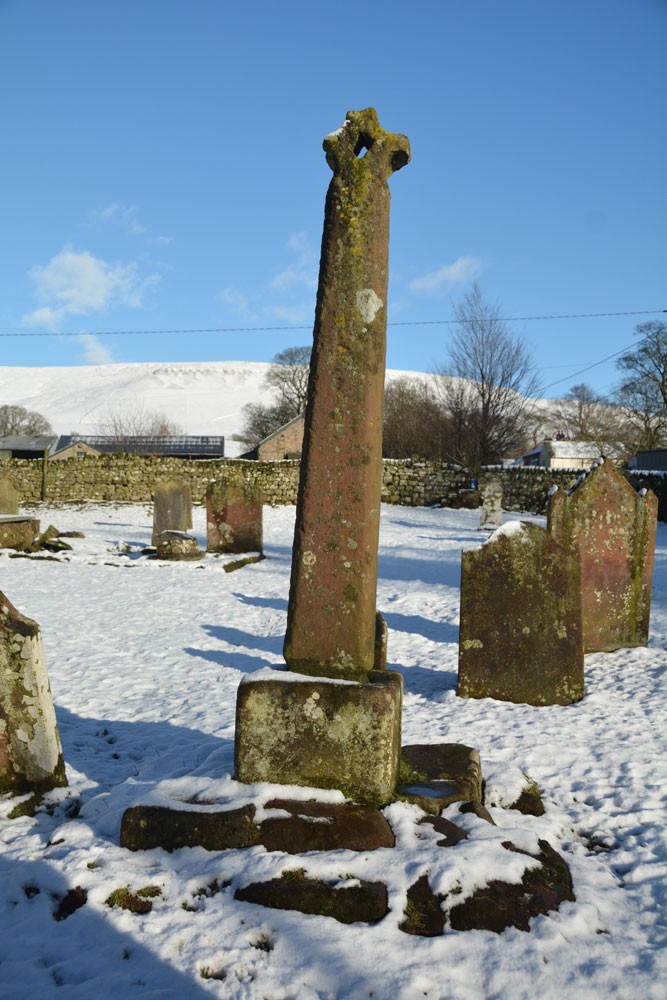
St Lawrence's Church (Kirkland) submitted by Anne T on 10th Feb 2018. Looking due east across one of the broad faces of the cross. I wondered where the small fragments of broken arm were; they weren't in the church, as we searched around for these. Probably long lost.
(View photo, vote or add a comment)
Log Text: Ancient Cross, St Lawrence's Church, Kirkland, Cumbria: The church itself is unremarkable, although a pretty stream runs just outside the southern wall of the churchyard. Parking is available just outside the church, on the grass, although on the day of our visit it was snowy and the ground was boggy, so we parked just over the bridge, just east of the T-junction.
The church was being renovated, so to avoid the scaffolding and a muddy walk right round the churchyard from the gate at the north-western edge of the church, we hopped across the small wire fence, meant for containing the sheep.
The cross is tall and slender, but with broken arms. We observed two channels in the base, where the cross shaft meets the base, from which melting snow water was running. On another cross base near Cairnpapple, Canmore recorded that similar channels were thought to be from the base being used as a drinking trough at some time in its past. Here, the channels seemed to serve as a way of getting rid of water which might run down between the cross shaft and its base.
Certainly a remote spot here, although plenty of farm traffic.
St Cuthbert's Church (Milburn)
Trip No.66 Entry No.3 Date Added: 10th Feb 2018
Site Type: Ancient Cross
Country: England (Cumbria)
Visited: Yes on 9th Feb 2018. My rating: Condition 2 Ambience 4 Access 5
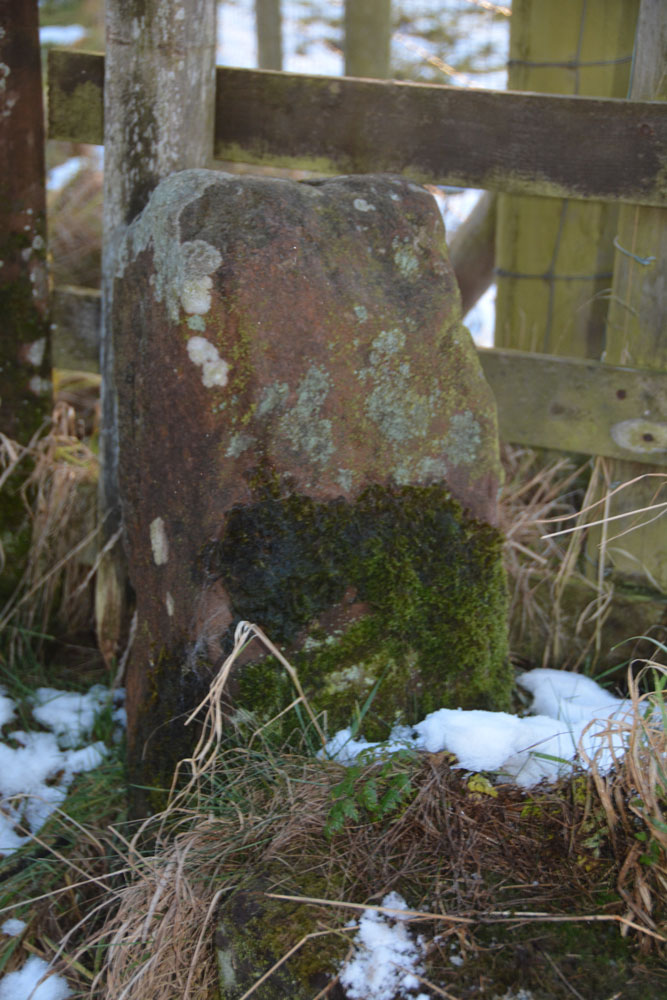
St Cuthbert's Church (Milburn) submitted by Anne T on 10th Feb 2018. Looking at the eastern face of the cross shaft. No carvings were visible on this face, and being so close to the fence and gate, it was difficult to get a clear look at the western and northern sides.
(View photo, vote or add a comment)
Log Text: Ancient cross and pre-Conquest sundial, Milburn, Cumbria: We scouted all around the churchyard for this cross, only to realise it was at the head of the access road from the village, so back-tracked to find it. It sits right by the northern gate post and we had mistaken it for part of the gate/fence structure, then we checked the grid reference and saw the hole in the top of the shaft, presumably either for another section or a smaller cross.
Going back down to the church, I found the pre-Conquest sundial, which is low down on the exterior stone door jamb of the western side of the south door. Thankfully I was able to pull up the Corpus of Anglo Saxon stone sculpture photograph to help me in the growing dusk.
The churchyard is really nicely kept and the Crowdundle Beck/Milburn Beck runs by the western side of the churchyard. A remote, by lovely spot.
St Edmund's Church (Newbeggin)
Trip No.66 Entry No.5 Date Added: 10th Feb 2018
Site Type: Ancient Cross
Country: England (Cumbria)
Visited: Yes on 9th Feb 2018. My rating: Condition 2 Ambience 4 Access 5
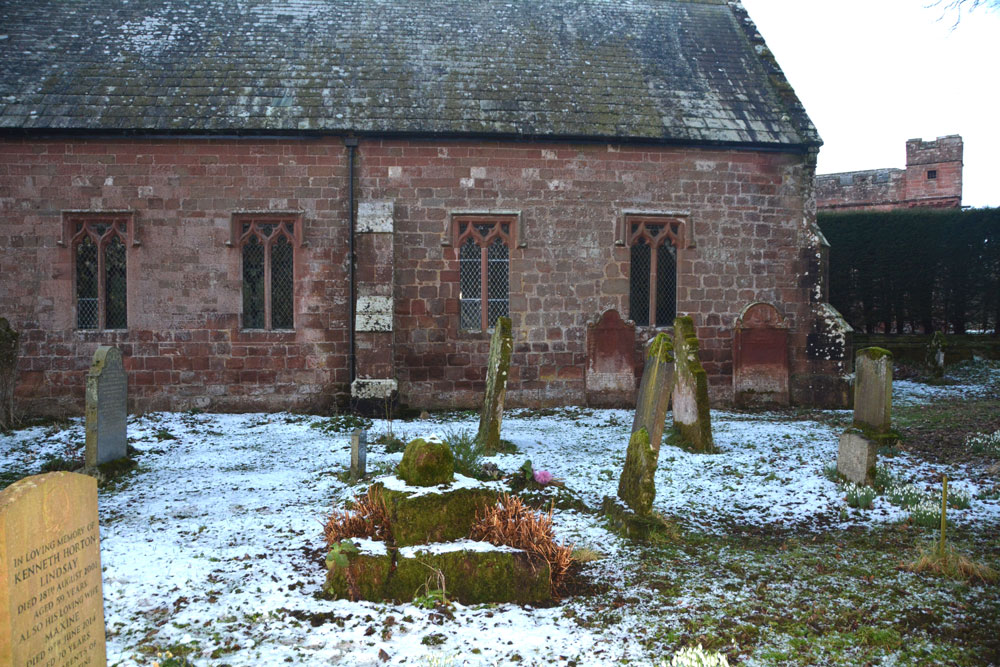
St Edmund's Church (Newbeggin) submitted by Anne T on 10th Feb 2018. Standing to the south of the cross base and shaft fragment, showing its proximity to the south of the nave/chancel.
(View photo, vote or add a comment)
Log Text: Cross base and remains of cross shaft, St. Edmunds Church, Newbeggin (Culgaith): We arrived here as dusk was dropping fast, so all my photos had to be taken with flash. Surprisingly, the church was still open, so we popped inside, but apart from a reading light near the pulpit, couldn't find any light switches. The church is a lot larger than it looks, and the grave yard is very full, so we had to pick our way over the graves and host of snowdrops to get to the cross.
The sundial nearer to the western churchyard wall was also interesting, although part of its lead gnomon had been pulled off.
It was very heavily encrusted in moss, and not wanting to damage it, left it without seeing if there were any carvings or features on it. Another church next to Crowdundle Burn (as is St. Cuthbert's in Milburn). A pretty spot. By the time we'd finished here, it was almost dark, so reluctantly had to set off back home.
Edenhall Cross (Langwathby)
Trip No.68 Entry No.1 Date Added: 6th Apr 2018
Site Type: Ancient Cross
Country: England (Cumbria)
Visited: Yes on 5th Apr 2018. My rating: Condition 3 Ambience 4 Access 5
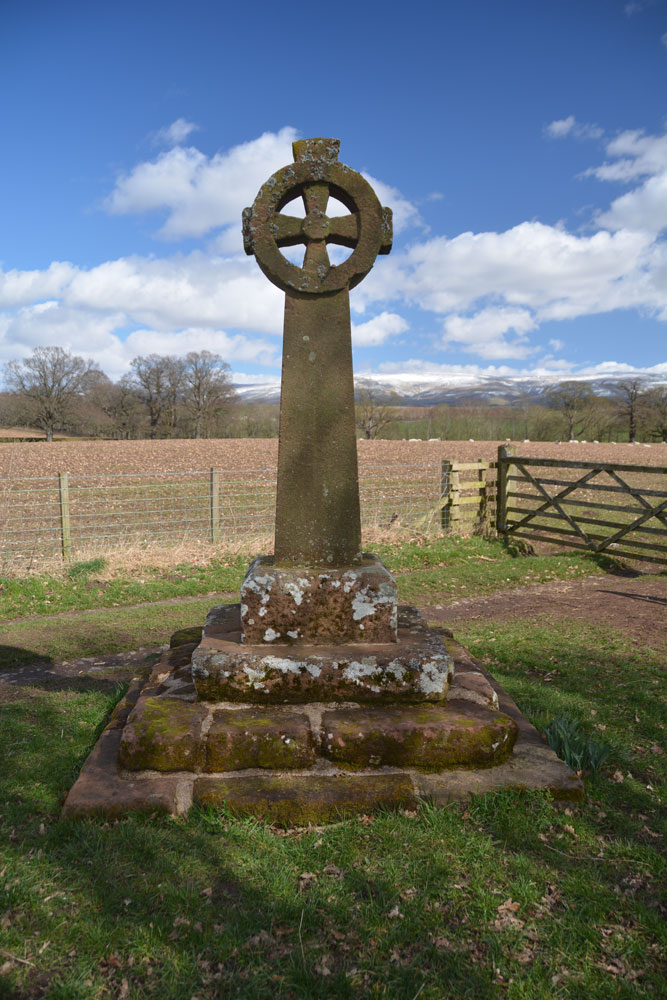
Edenhall Cross (Langwathby) submitted by Anne T on 6th Apr 2018. First view of the cross from the lane leading from Edenhall village to St. Cuthbert's Church. The River Eden runs 250 metres east of the cross. St. Cuthbert's church is 230m south east of the cross. The base looks very old, whereas the cross and shaft and head look as if they have been newly made, even though they were placed here in the 19th century.
(View photo, vote or add a comment)
Log Text: Edenhall Cross, near Langwathby, Cumbria: This is one of the crosses we didn't have time to visit on our last trip to Cumbria, and we picked a beautiful, if somewhat chilly day, to arrive.
No sooner had we pulled the car up by the cross to take some photographs, and I was wrestling with the lens of my camera, which had jammed, when a dog walker sidled up and asked us if we were planning on parking there. I said I was just going to take some photos, then we were heading down to the church; we wouldn't dream of blocking the gate into the field. The man looked mollified and moved on, only to be followed by a steady stream of dog walkers with large dogs.
The view across to the Pennines with their snow caps was lovely. The photographs didn't really do the scenery justice. A lovely spot.
St. Cuthbert's Church (Edenhall)
Trip No.68 Entry No.2 Date Added: 6th Apr 2018
Site Type: Ancient Cross
Country: England (Cumbria)
Visited: Yes on 5th Apr 2018. My rating: Condition 3 Ambience 4 Access 5
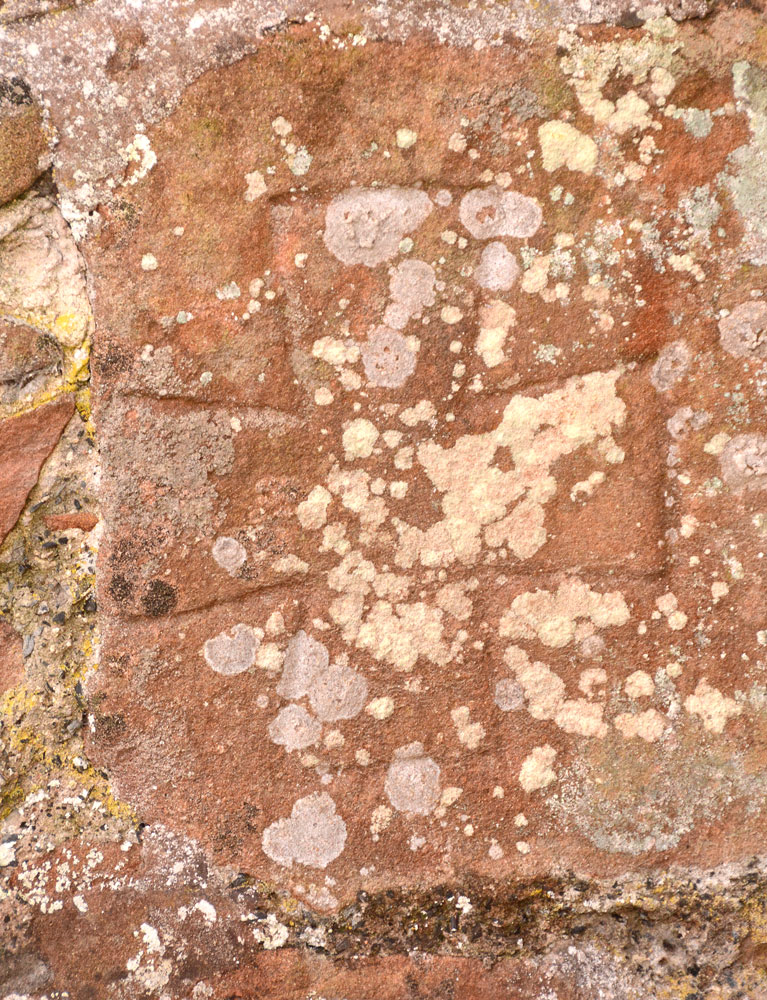
St. Cuthbert's Church (Edenhall) submitted by Anne T on 6th Apr 2018. Close up of the carved Anglo Saxon cross in the exterior north of the wall. Just to its east, and higher up the wall, is a blocked up Anglo Saxon window/window head.
(View photo, vote or add a comment)
Log Text: Anglo Saxon Cross at St. Cuthbert's Church, Edenhall: There is a small car park to the north of the church, and a tall/wide gate with a stile next to it to access the churchyard. This is a pretty, red sandstone building which looks as if it has been extended many times in antiquity.
There was no mention of anything on the Corpus of Anglo Saxon Stone Sculpture, although the church guide book mentions “the chancel appears to be pre-Norman or early Norman origin, and a small blocked up window high up in this wall is of Anglo Saxon type. Moreover, on the same wall, lower down, there is a carved Anglo Saxon cross. Thus the north wall may be the remains of an earlier church.”
The guide also mentions a Mass Dial on the south wall, to the east of the porch. We both spent about 20 mins looking up and down the length of the wall, both east and west of the porch, in strong sunlight which would have brought the markings out, but failed to find this. We did spot what looked like two fragments of carved cross shaft in the south wall of the tower, west of the porch. There was no mention of these in the guide or Pastscape or HE notes.
Roman Milestone (Temple Sowerby)
Trip No.68 Entry No.3 Date Added: 6th Apr 2018
Site Type: Marker Stone
Country: England (Cumbria)
Visited: Yes on 5th Apr 2018. My rating: Condition 3 Ambience 3 Access 5
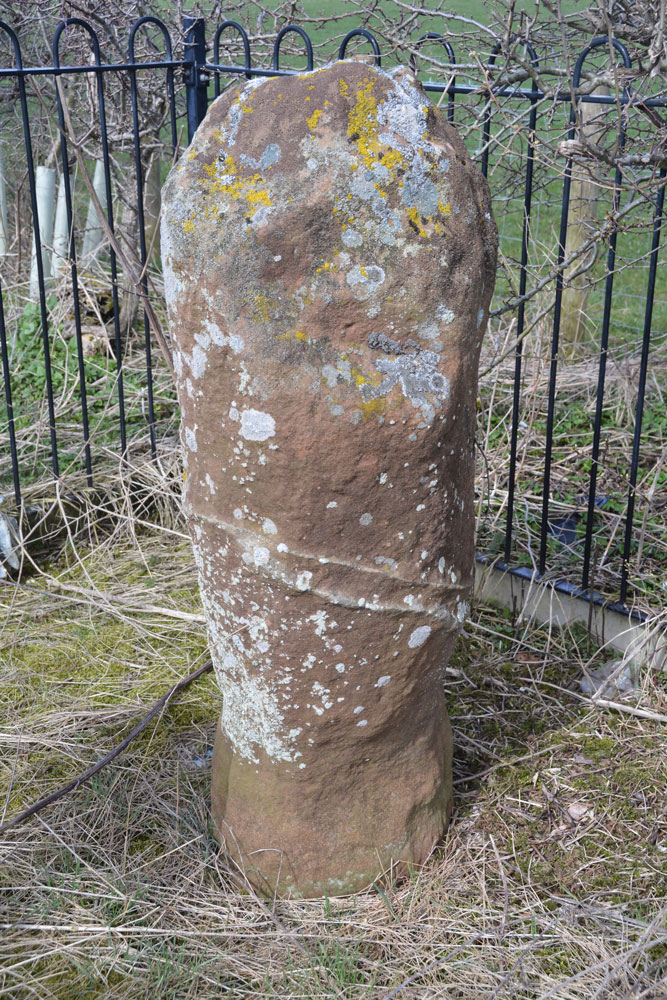
Roman Milestone (Temple Sowerby) submitted by Anne T on 6th Apr 2018. Close up of the southern face of the milestone. If there was an inscription, it has long been scoured away by the winds and rains. Today the A66 Temple Sowerby by-pass rushes by just to the west of this milestone. To think this has sat by a routeway for around 2,000 years.
(View photo, vote or add a comment)
Log Text: Roman Milestone, in its original position, Temple Sowerby: This was a very curious site - now a newly created 'dead end' and technically a private road. The milestone is hidden behind a mound of dirt and stones at the side of the road, protected by a metal railing. Traffic on the he modern A66 Temple Sowerby by-pass whizzes by at high speed. Shame the railing and hedge behind attracts so much rubbish - really spoiled the ambience.
To think this has been on an ancient routeway for such a long time. The weather has long scoured away any inscription. I have been trying to find out how they know it's in its original location, but haven't found out anything (yet).
